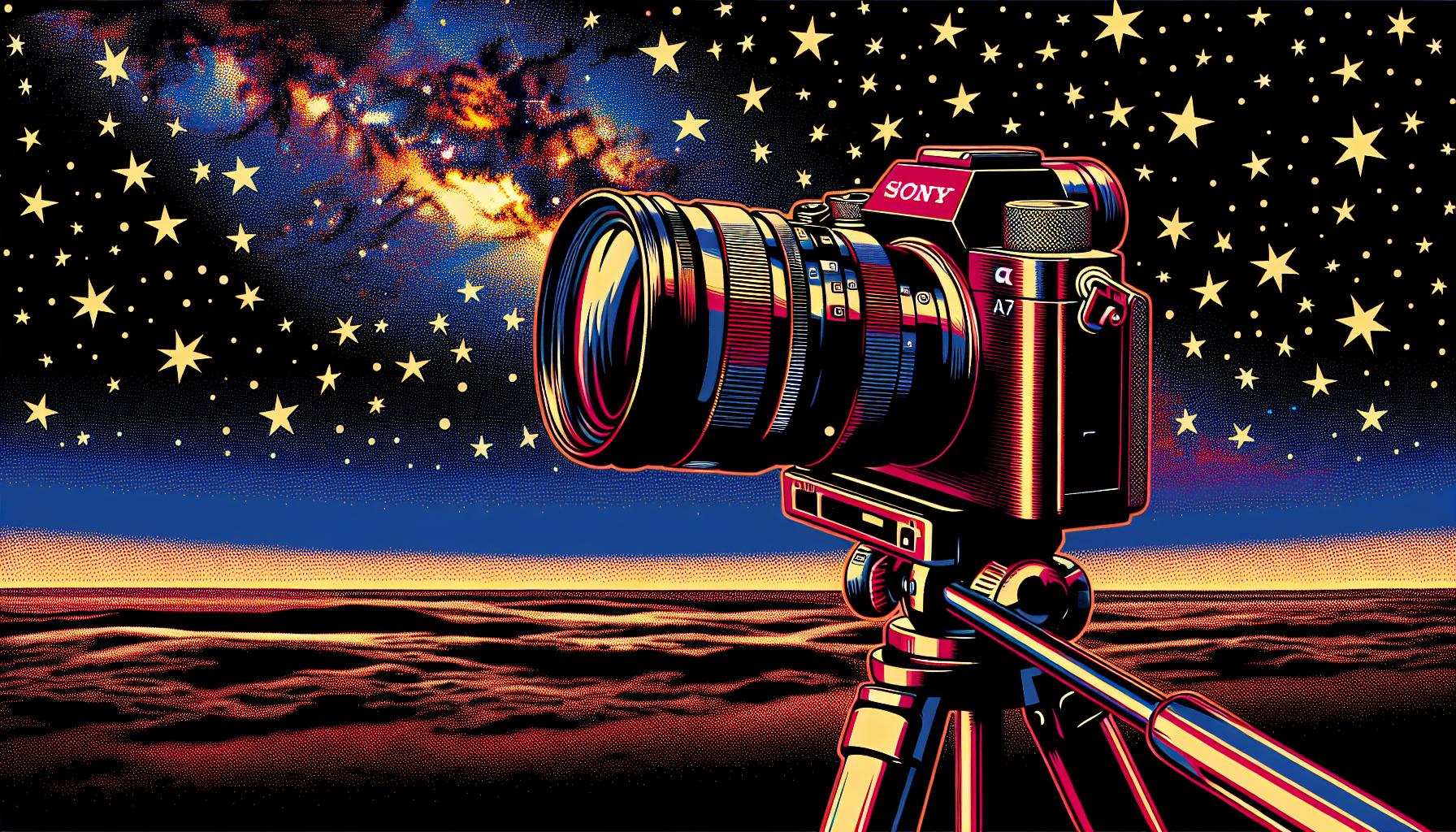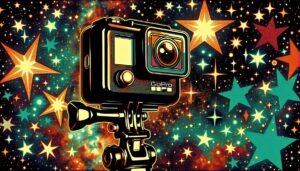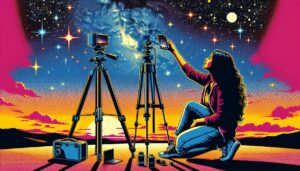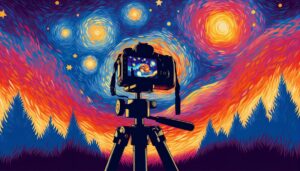This site contains affiliate links to products. I may receive a commission for purchases made through these links.
Astrophotography’s always been a passion of mine. There’s something magical about capturing the celestial bodies in all their glory. And when it comes to gear, the Sony A7’s been my go-to camera for this purpose. It’s not just any camera, it’s a tool that’s revolutionized my approach to astrophotography.
The Sony A7 series, known for its high-performance full-frame sensor, has been a game-changer in the world of photography. But it’s in the realm of astrophotography where it truly shines. The camera’s low light sensitivity and noise reduction capabilities make it an ideal choice for capturing the night sky.
In the coming paragraphs, I’ll be sharing my experiences with the Sony A7, and why I believe it’s the best camera for astrophotography. We’ll dive into its features, performance, and how it stands out from the competition. So, whether you’re a seasoned astrophotographer or just starting out, this article’s for you.
Features of the Sony A7 for Astrophotography
You might be wondering, “what makes the Sony A7 so superb for stargazing shots?” The answer lies in its high-end features. It’s not one, but a combination of several attributes that make this Sony marvel stand out in the world of astrophotography.
One major highlight of the Sony A7 is its full-frame sensor. When it comes to details, richness, and depth, nothing beats a full-frame sensor. Unlike smaller sensors, it performs exceptionally well in low-light conditions, which we encounter often when trying to capture the night sky. The fact that it’s a 24.3MP sensor means that you’ll get stunningly clear and crisp shots every time you click the shutter.
Another striking feature to note is the camera’s low light sensitivity. The ISO range of this model stretches from ISO 50 to ISO 204800. This broad spectrum allows for great flexibility in capturing the celestial bodies at various lighting levels.
Let’s not overlook the noise reduction capability. Noise tends to become a considerable issue when shooting in low-light conditions. However, Sony A7 tackles this problem head-on with its specialized noise reduction technology. It effectively cuts down the grainy effect, resulting in smoother and sharper night sky images.
The A7 series also boasts a fast and accurate autofocus system. With 117 phase-detection points and 25 contrast-detection points, it ensures quick focusing, letting you capture fleeting moments on the celestial canvas with clarity and precision.
Here is a table summarizing the key features of the Sony A7:
| Feature | Details |
|---|---|
| Sensor | Full-frame |
| Resolution | 24.3MP |
| ISO range | 50–204800 |
| Noise Reduction | Yes |
| Autofocus points | 117 phase-detection and 25 contrast-detection |
With these premium features, it’s not surprising why I prefer to rely on the Sony A7 for my astrophotography pursuits.
Low Light Sensitivity and Noise Reduction Capabilities
When shooting the night sky, you’re dealing with extremely low light levels. This is one area where the Sony A7 excels. Its full-frame sensor boasts incredible sensitivity in low light conditions, often making the difference between successfully capturing an image of a distant galaxy or missing it entirely.
Why is this so crucial for astrophotography? Photo ops in this field often happen in darkness, far removed from city lights. A camera’s ability to function well in low light isn’t just an added luxury; it’s a must. I’ve found the Sony A7’s low light sensitivity remarkably helpful in making the most out of my night sky shoots.
Ranked among its standout features is its in-built noise reduction system. In any low light photography, digital noise can be a significant issue. Excessive noise can make your photos look grainy and can obscure the finer details of your shots. The Sony A7 deals with this problem head-on. Its noise reduction capabilities ensure that even at high ISO settings, noise is kept to a minimum.
Clickable images or those with fine, eye-popping details can make or break your photographs.
| Highlights | Sony A7 |
|---|---|
| Low light sensitivity | Excellent |
| Noise reduction system | In-Built |
Certainly, the low light sensitivity of the Sony A7 paired with its potent noise reduction system is a winning combination for any astrophotographer. As an experienced astrophotographer, I appreciate the effort that Sony has put into these valuable features. They’ve transformed my ability to capture the beauty of the universe. Rest assured, with this camera in your bag, the beauty of the night sky is well within your reach. Making a quality leap in your astrophotography journey doesn’t have to be a distant dream.
Comparing the Sony A7 with Other Cameras for Astrophotography
When looking at other cameras considered suitable for astrophotography, it’s a delight to note how the Sony A7 compares favorably. Here, I’ll provide a comparative analysis between the Sony A7 and other top-tier options such as the Canon EOS 6D and the Nikon D810A.
For one, the Canon EOS 6D boasts a highly commendable ISO range up to 102400, which aligns it quite effectively for low light photography. However, in my experience with the Sony A7, it out-performs the 6D, thanks to its superior noise reduction capabilities. With the Sony A7, images have been consistently clearer and more detailed, even at extremely high ISO settings, creating a more rewarding astrophotography experience.
The Nikon D810A, on the other hand, is another tough competitor. Tailored explicitly for astrophotography and jam-packed with features like a specialized Infrared (IR) cut filter, many professionals admire this model. Though regardless of these custom features, I’ve found the Sony A7’s full-frame sensor enables me to capture distant galaxies with better light intake, producing higher quality images overall.
To visualize, here’s how these three top contenders line up in key areas.
| Feature | Sony A7 | Canon EOS 6D | Nikon D810A |
|---|---|---|---|
| Sensor | Full-frame | Full-frame | Full-frame |
| Maximum ISO | 409600 | 102400 | 51200 |
| Noise reduction | Excellent | Good | Good |
In the realm of astrophotography, the Sony A7’s superior low light sensitivity and highly-effective noise reduction system set it apart from the competitors. Even with renowned models like the Canon EOS 6D and the Nikon D810A, the Sony A7’s performance remained undiminished, outlining why it is indeed a prime choice for capturing the wonders of the celestial kind. It’s clear to see the A7 is a shining star in the constellation of cameras ideal for astrophotography.
Tips and Tricks for Astrophotography with the Sony A7
Given the capabilities of the Sony A7, I’ve compiled a list of tips and tricks to help you maximize its full potential for astrophotography. When you’re ready to venture out into the night for a shoot, keep these pointers in mind.
Firstly, understanding the camera’s settings is crucial. Familiarize yourself with the Sony A7’s manual settings. Use the camera in manual mode for full control over the exposure, shutter speed, and ISO. For astrophotography, I typically start with an ISO setting around 3200 and a shutter speed of 30 seconds. And, don’t forget to set your focus to infinity.
Secondly, remember it’s all about patience. Astrophotography isn’t something you master overnight; it can take a lot of trial and error to capture the perfect shot. That’s why I often suggest bringing an extra battery or a portable charger. You don’t want to miss out on a great shot because your camera’s battery dies.
Thirdly, invest in a sturdy tripod. It’s vital for astrophotography because it provides the stability you need for those long exposure shots. You’ll want one that’s sturdy enough to handle any breeze, yet light enough to carry around easily.
Dealing with darkness is a significant part of astrophotography. Be sure to bring a red light torch to preserve your night vision. It’ll help you see without disrupting your camera’s exposure settings.
Lastly, use the Sony A7’s built-in noise reduction feature. As we’ve previously discussed, this model excels in reducing noise, even at high ISO settings. Turn on the Long Exposure NR option to use this feature; it really helps to produce cleaner, sharper images.
Conclusion
There’s no denying that the Sony A7’s got some serious chops when it comes to astrophotography. This camera’s built-in noise reduction feature, coupled with the right settings and equipment, can help you capture the night sky like never before. Remember, patience is key and a sturdy tripod along with a red light torch can make all the difference.
It’s clear that with the Sony A7, the stars aren’t just within reach – they’re right at your fingertips. So go ahead, give it a shot and let the Sony A7 help you explore the cosmos from your own backyard.
Frequently Asked Questions
What are the capabilities of the Sony A7 for astrophotography?
The Sony A7 is highly capable for astrophotography, with advanced camera settings, built-in noise reduction feature, and the ability to capture stunning low-light images.
What are some tips for maximizing the Sony A7’s potential in astrophotography?
Understanding the camera’s settings, embracing patience, using a sturdy tripod, bringing a red light torch, and taking advantage of the Sony A7’s built-in noise reduction feature can all optimize results in astrophotography.
Why is a red light torch recommended for using the Sony A7 in astrophotography?
A red light torch is recommended as it helps to keep your eyes adjusted to the dark while setting up and operating your camera, thereby optimizing the shooting conditions.




